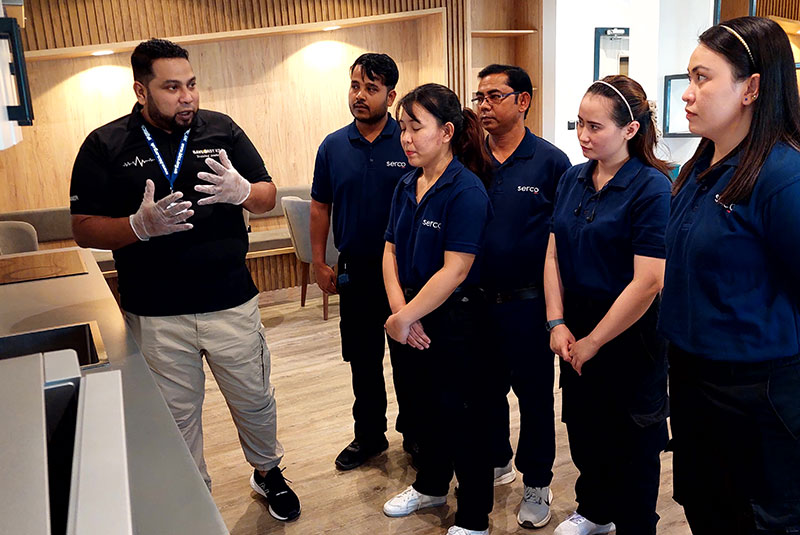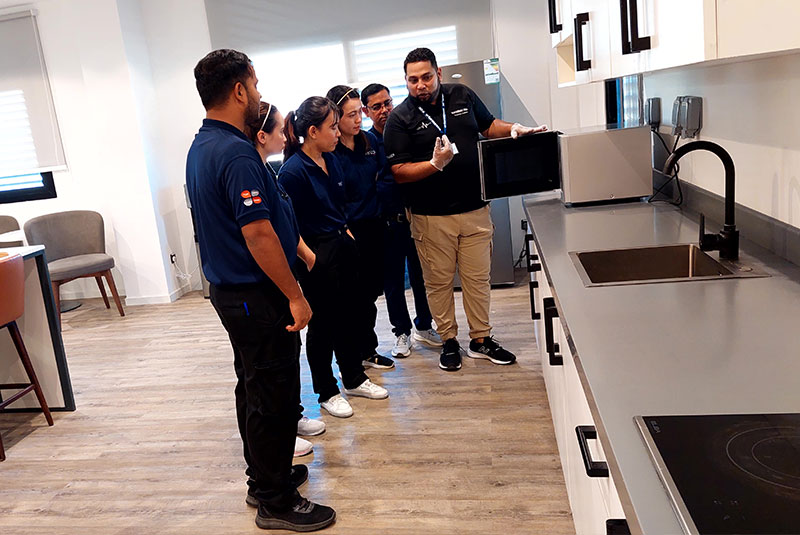
You can have the best resources (chemicals, technologies, etc) in the world but if you don’t train your employees, the resources will not be able to benefit you. Training enhances and elevates hygiene standards in every type of facility and in this section, we speak to Mohamad Hazath, Head of Department (BICSc) at SaveFast Training Academy to understand this further.
How can specialized training programs improve the overall cleanliness and hygiene standards in public spaces?
Specialized training programs can play a crucial role in improving overall cleanliness and hygiene standards in shared spaces by equipping individuals with the knowledge and skills necessary for effective sanitation practices. Here are some ways in which such programs can make a positive impact:
- Correct cleaning techniques,
- Understanding of hygiene protocols
- Identification and handling of hazardous materials
- Preventing cross-contamination
- Health and safety measures
- Regular training updates
- Promoting a culture of cleanliness
- Customer interaction skills
- Monitoring and evaluation
- Delivering best practice
Implementing systems for monitoring and evaluating cleanliness standards can be part of the training. Regular assessments and feedback loops can help identify areas for improvement and ensure ongoing effectiveness. Training is not a one-off event and should be updated and reviewed periodically.
By investing in specialized training programs that cover these aspects, shared public spaces can enhance their cleanliness and hygiene standards, creating safer and healthier environments for everyone.

What are the key components of a comprehensive cleaning training program aimed at elevating standards in hospitality industries?
A comprehensive cleaning training program for the hospitality industry should cover various key components to ensure that staff are equipped with the knowledge and skills needed to maintain high standards of cleanliness and hygiene. Here are some essential elements for such a training program.
Key components of a comprehensive cleaning training program for the hospitality industry include raising hygiene standards, equipment and chemical use and care, surface-specific cleaning techniques, infection control, time management, waste management, teamwork, attention to detail, emergency response, PPE usage, feedback mechanisms, cultural sensitivity, periodic refresher courses, quality control, documentation, and professionalism.
By integrating these key components, a comprehensive cleaning training program in the hospitality industry can contribute significantly to elevating cleanliness standards and creating a positive guest experience.
In what ways can incorporating technology into cleaning training enhance efficiency and effectiveness?
Incorporating technology into cleaning training enhances efficiency and effectiveness. Online platforms, virtual reality, and augmented reality offer flexible and immersive learning experiences. Mobile apps, digital manuals, and e-learning modules provide accessible, interactive resources. Remote monitoring, data analytics, and smart devices streamline performance evaluation, inventory management, and real-time feedback. Overall, technology accelerates learning, improves engagement, and optimizes cleaning processes.

By leveraging technology in cleaning training programs, organizations can streamline processes, enhance learning experiences, and ultimately improve the efficiency and effectiveness of their cleaning practices.
How do ongoing education and skill development contribute to maintaining elevated cleaning standards in various environments?
Ongoing education and skill development are crucial for maintaining elevated cleaning standards. Regular training ensures adaptation to industry changes, introduces new technologies, and enhances problem-solving abilities. It contributes to efficient time management, consistent quality control, and a proactive approach, leading to improved customer satisfaction. Additionally, it fosters employee engagement, cultural sensitivity, and environmentally friendly practices, ensuring cleaning professionals are well-equipped for various environments.
What role does leadership and management play in ensuring consistent adherence to elevated cleaning standards among cleaning staff?
Leadership and management are critical for ensuring consistent adherence to elevated cleaning standards among staff. This involves setting clear expectations, providing comprehensive training, regular communication, monitoring and supervision, resource allocation, quality control, recognition, and support. Effective leaders lead by example, empower employees, and adapt to changing needs, fostering a positive culture of excellence in cleanliness.
Can you provide examples of successful case studies where implementing rigorous cleaning training resulted in noticeable improvements in public health outcomes?
Aimed to improve and elevate cleaning standards across all its hospitals, focusing on efficiency, cost reduction, waste reduction, and the implementation of consistently high standards through a standardized approach and framework. The goal was to ensure that all cleaning operators meet a minimum requirement through training.
Pilot Program at Healthcare
To kickstart the initiative, a pilot program was implemented at healthcare center. The program utilized the expertise of the British Institute of Cleaning Science (BICSc), the largest independent body in the cleaning industry, known for providing essential skills required for carrying out cleaning tasks and offering a license to practice.
BICSc Standard Cleaning Outcome Criteria:
The BICSc audit employed three possible outcomes based on their Standard Cleaning Outcome Criteria:
Fail, Action Needed, Pass
Initial Audit:
During the initial Audit, Hospital scored 28%, categorizing the hospital’s cleaning standards as a failure. The major issues identified included untrained cleaning operators, cross-contamination risks, a lack of knowledge about cleaning agents and machinery, and a general lack of understanding of standard cleaning processes.
Issues Identified:
Untrained Cleaning Operators: A significant proportion of the cleaning staff lacked proper training.
Cross-Contamination Risks: Practices that could lead to cross-contamination were observed.
Lack of Knowledge about Cleaning Agents and Machinery: Cleaning staff showed a lack of understanding regarding the proper use of cleaning agents and machinery.
Lack of Understanding of Standard Processes: The absence of standardized cleaning processes contributed to the subpar results.
Training Intervention:
Addressing these issues, a comprehensive training program was implemented at respected hospital in collaboration with BICSc. The training covered essential cleaning skills, proper use of cleaning agents and machinery, and adherence to standardized cleaning processes.
Post-Training Assessment:
Following the training program, healthcare center underwent a reassessment and demonstrated a remarkable improvement, scoring 63%, marking an exceptional result.
Results Achieved:
Significant Increase in Score: The hospital’s score increased by 35 percentage points, showcasing a substantial enhancement in cleaning standards.
Addressed Untrained Cleaning Operators: The training program successfully addressed the issue of untrained cleaning operators.
Improved Understanding of Cleaning Agents and Machinery: Cleaning staff exhibited a better understanding of the correct use of cleaning agents and machinery.
Enhanced Adherence to Standard Processes: The implementation of standardized cleaning processes led to a more structured and efficient approach.
Conclusion:
The successful pilot program at Healthcare center, guided by the BICSc standards and training, demonstrated the potential for achieving elevated cleaning standards across all hospitals. The improvement not only ensures a cleaner and safer environment but also contributes to efficiency gains and cost reduction, aligning with the all the healthcare sector commitment to excellence in healthcare facilities. Ongoing training and adherence to standardized cleaning processes will be pivotal in sustaining and further elevating these cleaning standards across the entire healthcare sector network.
What strategies can be employed to address cultural or language barriers when delivering cleaning training programs to diverse workforce populations?
To overcome language and cultural barriers in cleaning training, organizations can employ strategies such as providing multilingual materials, incorporating cultural awareness, using visual aids, offering interpreter services, and fostering peer support, ensuring effective communication and understanding among diverse workforce populations.
How can incorporating sustainability principles into cleaning training programs contribute to both environmental conservation and improved cleaning standards?
Incorporating sustainability principles into cleaning training programs benefits both environmental conservation and cleaning standards. By educating staff on eco-friendly products, waste reduction, and energy-efficient practices, organizations promote a more sustainable approach to cleaning operations. This not only minimizes the environmental impact but also elevates cleaning standards through the use of green certifications, sustainable equipment, and policies, fostering a culture of responsibility among cleaning staff.
What measures should be taken to assess the effectiveness of cleaning training initiatives and identify areas for improvement?
To assess the effectiveness of cleaning training initiatives and identify areas for improvement, organizations should utilize performance metrics, conduct before-and-after assessments, implement quality control inspections, gather employee and supervisor feedback, analyze incident reports, distribute surveys, conduct skills assessments, utilize training evaluation forms, perform ongoing training needs analysis, benchmark against industry standards, leverage technology-based monitoring, consider customer complaints and compliments, offer regular training refreshers, and conduct a cost-benefit analysis.
In what ways can collaboration between cleaning professionals, facility managers, and industry regulators facilitate the development and implementation of standardized cleaning training programs?
Collaboration between cleaning professionals, facility managers, and industry regulators is essential for the development and implementation of standardized cleaning training programs. This collaboration involves needs assessments by cleaning professionals to address industry-specific challenges, regulatory oversight to ensure compliance with standards, and resource allocation by facility managers. Together, they tailor training programs to facility requirements, continually improve content based on real-world feedback, and align training with organizational goals. This collaborative effort also enables industry benchmarking, risk assessment and mitigation, and integration of new technologies. Additionally, it fosters knowledge sharing through forums, networking events, and the creation of professional development opportunities, ensuring a holistic and effective approach to cleaning practices in diverse facilities.
Reference:
SaveFast clients that have actively conducted the Licence to Practice as the minimum standard for their cleaning staff include prestigious names such as:
- Riyadh Metro Project
- Flow Consortium
- Ministry Of Health
- Shapoorji Pallonji
- Jash Technical Services
- Ifas
- Al-Yamama Group
SaveFast and BICSc are continuing to work with the different Saudi government agencies to seek a universal mandated status for the BICSc LTP, thus ensuring that citizens, residents and visitors to the Kingdom can enjoy an environment that is second- to-none, when it comes to cleanliness and hygiene.

